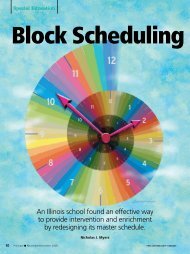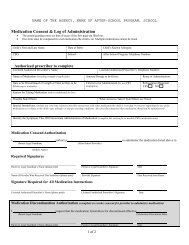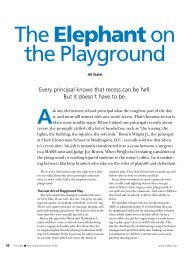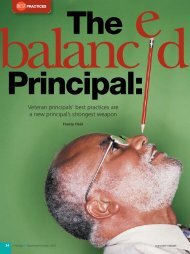What the Research Says About the Importance of Principal Leadership
What the Research Says About the Importance of Principal Leadership
What the Research Says About the Importance of Principal Leadership
Create successful ePaper yourself
Turn your PDF publications into a flip-book with our unique Google optimized e-Paper software.
National Association <strong>of</strong> Secondary School <strong>Principal</strong>s1904 Association DriveReston, Virginia 20191703-860-0200www.nassp.orgNASSP (National Association <strong>of</strong> Secondary School <strong>Principal</strong>s) is <strong>the</strong> leading organization <strong>of</strong> andnational voice for middle level and high school principals, assistant principals, and all school leadersfrom across <strong>the</strong> United States and 36 countries around <strong>the</strong> world. The association provides researchbasedpr<strong>of</strong>essional development and resources, networking, and advocacy to build <strong>the</strong> capacity <strong>of</strong>middle level and high school leaders to continually improve student performance. Reflecting its longstandingcommitment to student leadership development as well, NASSP administers <strong>the</strong> NationalHonor Society, National Junior Honor Society, National Elementary Honor Society, and NationalAssociation <strong>of</strong> Student Councils. For more information about NASSP, visit www.nassp.org.National Association <strong>of</strong> Elementary School <strong>Principal</strong>s1615 Duke StreetAlexandria, Virginia 22314703-684-3345www.naesp.orgEstablished in 1921, <strong>the</strong> National Association <strong>of</strong> Elementary School <strong>Principal</strong>s (NAESP) is <strong>the</strong> leadingnational association representing <strong>the</strong> nation’s elementary and middle school principals in <strong>the</strong> UnitedStates, Canada, and overseas. NAESP believes principals are primary catalysts for creating lastingfoundations for learning in <strong>the</strong>ir commitment to all children. NAESP hosts <strong>the</strong> Federal RelationsNetwork and develops policy to advance <strong>the</strong> principals’ pr<strong>of</strong>ession at <strong>the</strong> national level. In additionto advocating for sound policies in pre-K–3 alignment, principal preparation and evaluation, andbuilding <strong>the</strong> capacity <strong>of</strong> new principals, <strong>the</strong> association provides a variety <strong>of</strong> high-quality and targetedpr<strong>of</strong>essional development programs, including mentoring for early-career principals.© 2013 National Association <strong>of</strong> Secondary School <strong>Principal</strong>s and National Association <strong>of</strong> Elementary School <strong>Principal</strong>s. All rights reserved.ii <strong>Leadership</strong> Matters
<strong>Leadership</strong> MattersGreat schools do not exist apart from great leaders. NASSP and NAESP havealways asserted this reality with confidence, but <strong>the</strong> past few years haveprovided volumes <strong>of</strong> high-quality research that confirm it. More importantly,recent research by <strong>the</strong> Wallace Foundation and o<strong>the</strong>r groups has broughtinto focus <strong>the</strong> behaviors and priorities <strong>of</strong> effective principals and <strong>the</strong> measured impact <strong>of</strong>principal leadership on student learning. This document compiles <strong>the</strong> research and makes acompelling case that, as <strong>the</strong> title suggests, leadership matters.Unfortunately, our priorities have not yet caught up to <strong>the</strong> research. <strong>Principal</strong> developmentremains a low priority in most education policy agendas. The recent round <strong>of</strong> NCLB waiversprompted a rush to create new principal evaluation tools, most <strong>of</strong> which emphasize testscores over capacity building. And we continue to receive reports <strong>of</strong> principal preparationprograms that fail to graduate principals with <strong>the</strong> skills necessary to lead schools in <strong>the</strong> 21stcentury. With all we now know about effective leadership, we can no longer make excusesfor inadequate preparation and development.For our two organizations, representing <strong>the</strong> nation’s 100,000-plus principals and assistantprincipals, this document is a platform to reinforce to stakeholders <strong>the</strong> importance <strong>of</strong> <strong>the</strong>principal’s role. And we invite all who read it to help us share that message.Sincerely,JoAnn BartolettiExecutive Director, NASSPGail ConnellyExecutive Director, NAESP
<strong>Leadership</strong>MattersIn today’s climate <strong>of</strong> heightened expectations,principals are in <strong>the</strong> hot seat to improve teachingand learning. They need to be educationalvisionaries; instructional and curriculum leaders;assessment experts; disciplinarians; communitybuilders; public relations experts; budget analysts;facility managers; special program administrators;and expert overseers <strong>of</strong> legal, contractual, and policymandates and initiatives. They are expected to broker <strong>the</strong><strong>of</strong>ten-conflicting interests <strong>of</strong> parents, teachers, students,district <strong>of</strong>ficials, unions, and state and federal agencies,and <strong>the</strong>y need to be sensitive to <strong>the</strong> widening range<strong>of</strong> student needs. Although that job description soundsoverwhelming, at least it signals that <strong>the</strong> field has begunto give overdue recognition to <strong>the</strong> indispensable role <strong>of</strong>and mounting demands on principals (DeVita, as citedin Davis, Darling-Hammond, LaPointe, & Meyerson,2005, p. i).This assessment <strong>of</strong> <strong>the</strong> importance <strong>of</strong> principals isechoed repeatedly by educators, researchers focused onleadership, and organizations concerned with ensuringthat all students have access to high-quality schools.For example, a report issued by <strong>the</strong> Sou<strong>the</strong>rn RegionalEducation Board suggests that “a principal can impact<strong>the</strong> lives <strong>of</strong> anywhere from a few hundred to a fewthousand students during a year” (Schmidt-Davis &Bottoms, 2011, p. 2).But—and this is key to understanding how a goodprincipal supports high levels <strong>of</strong> teaching and learning—“it is nei<strong>the</strong>r teachers alone nor principals alone whoimprove schools, but teachers and principals working toge<strong>the</strong>r”(Schmidt-Davis & Bottoms, 2011, p. 2). <strong>Principal</strong>sare increasingly expected to lead <strong>the</strong>ir schools within aframework <strong>of</strong> collaboration and shared decision makingwith teachers and o<strong>the</strong>r staff members.Linking <strong>Principal</strong> <strong>Leadership</strong> andStudent LearningFor more than a decade, <strong>the</strong> Wallace Foundation hassponsored rigorous research on school leadership. In arecent report, <strong>the</strong> foundation highlighted an importantmessage from <strong>the</strong> research: “A particularly noteworthyfinding is <strong>the</strong> empirical link between school leadershipand improved student achievement” (Wallace Foundation,2011, p. 3). The foundation said about this link:Education research shows that most school variables,considered separately, have at most smalleffects on learning. The real pay<strong>of</strong>f comes whenindividual variables combine to reach criticalmass. Creating <strong>the</strong> conditions under which thatcan occur is <strong>the</strong> job <strong>of</strong> <strong>the</strong> principal. (WallaceFoundation, 2011, p. 2)<strong>Research</strong>ers Louis, Leithwood, Wahlstrom, and Anderson(2010) concurred with this assessment and drewfrom findings <strong>of</strong> a research project that spanned sixyears:In developing a starting point for this six-yearstudy, we claimed, based on a preliminary review<strong>of</strong> research, that leadership is second only toclassroom instruction as an influence on studentlearning. After six additional years <strong>of</strong> research,we are even more confident about this claim. Todate we have not found a single case <strong>of</strong> a schoolimproving its student achievement record in <strong>the</strong>absence <strong>of</strong> talented leadership. Why is leadershipcrucial? One explanation is that leaders have <strong>the</strong>potential to unleash latent capacities in organizations.(p. 9)2 <strong>Leadership</strong> Matters
■ Improving instruction to enable teachers toteach at <strong>the</strong>ir best and students to learn at<strong>the</strong>ir utmost.■ Managing people, data and processes t<strong>of</strong>oster school improvement. (p. 4, boldfaceremoved)The report identified an important qualificationabout those key leader functions:Each <strong>of</strong> <strong>the</strong>se five tasks needs to interact with <strong>the</strong>o<strong>the</strong>r four for any part to succeed. It’s hard tocarry out a vision <strong>of</strong> student success, for example,if <strong>the</strong> school climate is characterized by studentdisengagement, or teachers don’t know whatinstructional methods work best for <strong>the</strong>ir students,or test data are clumsily analyzed. When all fivetasks are well carried out, however, leadership isat work. (Wallace Foundation, 2011, p. 5)A report from Mid-Continent <strong>Research</strong> for Educationand Learning (McREL) spoke to <strong>the</strong> importance <strong>of</strong> <strong>the</strong>vision set by <strong>the</strong> principal:Effective school leaders know how to focus <strong>the</strong>work <strong>of</strong> <strong>the</strong> school on <strong>the</strong> essential. They havea clear mission or purpose for <strong>the</strong> school andidentify goals that align with that mission. Theycommunicate <strong>the</strong> purpose and goals in a meaningfulway such that all stakeholders understandwhat <strong>the</strong>y need to do. (McIver, Kearns, Lyons, &Sussman, 2009, p. 12)Finally, a study <strong>of</strong> principals in high-need districtscharacterized most <strong>of</strong> those principals as falling into one<strong>of</strong> two categories—“transformers” or “copers.”The “transformers” [<strong>the</strong> more effective principals]had an explicit vision <strong>of</strong> what <strong>the</strong>ir schoolmight be like and brought a “can-do” attitude to<strong>the</strong>ir job.... [They] focused intently on creating aculture in which each child can learn. Giving upis not an option. (Johnson, Rochkind, & Doble,2008, p. 3)In contrast, <strong>the</strong> copers were “typically struggling toavoid being overwhelmed” (Johnson et al., 2008, p. 3).<strong>What</strong> might those principal behaviors look like ineveryday terms? Let’s look at two examples: <strong>the</strong> impact<strong>of</strong> <strong>the</strong> principal on attracting and retaining a high-qualityteaching staff and <strong>the</strong> principal’s need to focus on <strong>the</strong>“right stuff.”School leaders improve teaching andlearning indirectly and most powerfullythrough <strong>the</strong>ir influence on staffmotivation, commitment, and workingconditions.Good <strong>Principal</strong>s Attract, Support, and Retain aHigh-Quality Teaching Staff(Leithwood, Day, Sammons,Harris, & Hopkins, 2006, p. 5)Pick <strong>the</strong> right school leader and great teacherswill come and stay. Pick <strong>the</strong> wrong one and,over time, good teachers leave, mediocre onesstay, and <strong>the</strong> school gradually (or not so gradually)declines. Reversing <strong>the</strong> impact <strong>of</strong> a poorprincipal can take years. (Cerf, as cited in Mitgang,2008, p. 3)Johnson (2006) agreed and viewed <strong>the</strong> principal as<strong>the</strong> “broker <strong>of</strong> workplace conditions”—someone whose“influence on <strong>the</strong> school as a workplace for teachersextends well beyond being in charge <strong>of</strong> <strong>the</strong> school” (p.15). For example, a survey <strong>of</strong> 40,000 teachers conductedby Scholastic and <strong>the</strong> Bill & Melinda Gates Foundation(2010) asked teachers about <strong>the</strong> factors that affectretention. This study found that “supportive leadershipis <strong>the</strong> standout, top-ranked item” (p. 39). O<strong>the</strong>r studieshave made similar findings about <strong>the</strong> importance <strong>of</strong>leadership on teachers’ attitudes about <strong>the</strong>ir workingconditions:■ Using data from a study <strong>of</strong> North Carolina teachers,Ladd (2009) found that “school leadership emergesas <strong>the</strong> most consistently relevant measure <strong>of</strong> workingconditions” (p. 29).4 <strong>Leadership</strong> Matters
■ In ano<strong>the</strong>r study, Hirsch, Frietas, Church, and Villar(2008) found that “two to three times as many teacherswho say <strong>the</strong>y want to remain in <strong>the</strong>ir currentschools agreed with positive statements about schoolleadership...than did teachers who want to remain in<strong>the</strong> pr<strong>of</strong>ession but move to a different school”(p. vii).■ In response to a study conducted in South Carolina,more than one-quarter <strong>of</strong> <strong>the</strong> teachers identifiedleadership as <strong>the</strong> “most crucial working conditionin making <strong>the</strong>ir decisions about whe<strong>the</strong>r to stay ina school,” and this factor was “significantly predictive<strong>of</strong> teacher retention” (Center for ComprehensiveSchool Reform and Improvement, 2007, p. 2).■ Maryland teachers emphasized <strong>the</strong> importance <strong>of</strong>school leadership on teaching retention:School leadership was <strong>the</strong> most importantcondition affecting teachers’ willingness to remainteaching at <strong>the</strong>ir school. Teachers whoindicated that <strong>the</strong>y plan to remain teachingin <strong>the</strong>ir school were twice as likely to agree<strong>the</strong>y work in trusting and supportive environments.(Hirsch, Sioberg, & Germuth, 2010, p.vii)Finally, <strong>the</strong> importance <strong>of</strong> <strong>the</strong> school principal inmaking—or breaking—a teacher’s first years in <strong>the</strong> pr<strong>of</strong>essionis highlighted in a report by <strong>the</strong> Public EducationNetwork (2003):New teachers working in schools run by principals<strong>the</strong>y describe as effective and competenthad a much easier transition into teaching....Teachers gave high marks to principals whomade it easy for <strong>the</strong>m to ask questions anddiscuss problems, and those that provided <strong>the</strong>mwith assistance, guidance, and solutions. (p. 22)Good <strong>Principal</strong>s Manage Their Personal Time andPriorities to Focus on <strong>the</strong> Right Stuff“The principal’s job is complex and multidimensional,and <strong>the</strong> effectiveness <strong>of</strong> principals depends, in part,on…how <strong>the</strong>y allocate <strong>the</strong>ir time across daily responsibilities”(Rice 2010, p. 2). <strong>Research</strong>ers Leithwood et al.(2004) agreed: “Leaders’ contributions to student learning,<strong>the</strong>n, depend a great deal on <strong>the</strong>ir judicious choice<strong>of</strong> what parts <strong>of</strong> <strong>the</strong>ir organization to spend time andattention on. Some choices…will pay <strong>of</strong>f much more thano<strong>the</strong>rs.” (p. 11)Recent research is helping to better define what<strong>the</strong> right stuff might be. Many <strong>of</strong> <strong>the</strong> discussions aboutprincipal leadership have focused on instructionalleadership—stressing that this should be <strong>the</strong> core <strong>of</strong>a principal’s job. But <strong>the</strong> definition <strong>of</strong> instructionalleadership is evolving.For example, in a study <strong>of</strong> Florida principals, Horng,Klasik, and Loeb (2010) found that, on average, <strong>the</strong>yspent less than 10% <strong>of</strong> <strong>the</strong>ir time on functions traditionallydefined as instruction (such as classroom observationsand pr<strong>of</strong>essional development for teachers).Almost 30% <strong>of</strong> <strong>the</strong>ir time was spent on administrativeactivities, including student supervision, scheduling,and compliance issues; about 20% <strong>of</strong> <strong>the</strong>ir time wasspent on “organizational management.” In addition, <strong>the</strong>researchers found that devoting more time to organizationalmanagement was correlated with higher studentachievement as reflected by test scores. In contrast, timespent on instructional activities was ei<strong>the</strong>r not or onlymarginally related to student performance.On <strong>the</strong> surface, <strong>the</strong>se findings seem to undermine<strong>the</strong> argument that <strong>the</strong> principal is <strong>the</strong> instructional leader<strong>of</strong> a school. But it is important to first look at <strong>the</strong> types<strong>of</strong> activities—such as ensuring that <strong>the</strong> school is safe,managing <strong>the</strong> budget and o<strong>the</strong>r resources, and dealingwith concerns from teachers—included in organizationalmanagement. Effectively addressing suchconcerns provides staff members and students with awell-organized, learning-focused environment in whichto work. Thus, <strong>the</strong>se recent findings “do not necessarilycontradict <strong>the</strong> body <strong>of</strong> research arguing for principals asinstructional leaders, but this new evidence does helpnuance [sic] that argument by broadening <strong>the</strong> definition<strong>of</strong> instructional leadership to include organizationalmanagement skills” (Rice, 2010, p. 3). Grissom and Loeb(2009) conducted a similar study and agreed with Rice’sassessment:<strong>Principal</strong>s devoting significant time and energyto becoming instructional leaders in <strong>the</strong>ir schools<strong>Leadership</strong> Matters 5
are unlikely to see improvement unless <strong>the</strong>yincrease <strong>the</strong>ir capacity for organizational managementas well. Effective instructional leadershipcombines an understanding <strong>of</strong> <strong>the</strong> instructionalneeds <strong>of</strong> <strong>the</strong> school with an ability to targetresources where <strong>the</strong>y are needed, hire <strong>the</strong> bestavailable teachers, provide teachers with <strong>the</strong> opportunities<strong>the</strong>y need to improve, and keep <strong>the</strong>school running smoothly. (p. 32)Effective principals agree with this assessment. Blase,Blase, and Phillips (2010) interviewed 20 principalswho had been recognized by <strong>the</strong>ir state departments <strong>of</strong>education as a “high-performing principal <strong>of</strong> a highperformingor significantly improving school” (p. xxvii).These principals indicated thateffective administrative leadership provides astable, predictable, and supportive foundationfor a high-performing school...[and] that effectiveadministrative and instructional leadershipare inextricably intertwined and interdependentprocesses. (p. xxviii)<strong>What</strong> Stands in <strong>the</strong> Way <strong>of</strong> EffectiveSchool <strong>Leadership</strong>?It is important to celebrate <strong>the</strong> principalship and talkabout <strong>the</strong> positive impact that effective principals haveon <strong>the</strong>ir schools. But <strong>the</strong> broader view <strong>of</strong> celebrating<strong>the</strong> principalship should include recognizing that everyschool—and every student—deserves such a principal.And <strong>the</strong> bottom line is that <strong>the</strong>re are barriers to ensuringthis happens.Many principals feel that <strong>the</strong>y have multiple, <strong>of</strong>tenconflictingpriorities and that not everything can alwaysbe done well. They have multiple constituencies—students,teachers, parents, school board members, andsuperintendents—and feel that <strong>the</strong>y are always on calland must respond to <strong>the</strong> needs <strong>of</strong> those groups. Timeis fragmented; principals speak <strong>of</strong> <strong>the</strong> intense effortneeded to find time to focus on important issues when<strong>the</strong>re are myriad administrative tasks that must be done.Often, <strong>the</strong>y feel that <strong>the</strong> leadership aspect <strong>of</strong> <strong>the</strong> job isshortchanged.Johnson (2005) interviewed principals who hadvoluntarily left <strong>the</strong>ir principalships after serving from2 to more than 10 years. Reasons provided by <strong>the</strong>seprincipals for <strong>the</strong>ir decisions included:■ A discrepancy between <strong>the</strong> level <strong>of</strong> accountabilityexpected <strong>of</strong> principals and <strong>the</strong> lack <strong>of</strong> influence<strong>the</strong>y really have over many factors affecting schoolsuccess■ A sense <strong>of</strong> being isolated when dealing withchallenges■ A workload that sometimes seems simply not doable■ Preservice training that left <strong>the</strong>m feeling unpreparedfor <strong>the</strong> challenges <strong>of</strong> <strong>the</strong> job.School-level leadership is most productivewhen couched within a supportive and consistent district-levelleadership that sets <strong>the</strong> vision andexpec tations but is willing to stepback and take <strong>the</strong> risk <strong>of</strong> allowing <strong>the</strong>principal <strong>of</strong> <strong>the</strong> school to lead withsome autonomy.(American Institutes for <strong>Research</strong>, 2010, p. 5)The District-School ConnectionThe accountability-influence gap <strong>of</strong>ten mentioned byprincipals deserves special attention. A Sou<strong>the</strong>rn RegionalEducation Board (SREB) project included interviewswith principals about <strong>the</strong> district-school connection.Some <strong>of</strong> <strong>the</strong> principals viewed <strong>the</strong>mselves as spending“time and effort finding ways to work around <strong>the</strong>district <strong>of</strong>fice to improve student achievement” (Bottoms& Fry, 2009, p. v, emphasis added). Ano<strong>the</strong>r SREB reportalso addressed <strong>the</strong> district-school connection:Plainly put, <strong>the</strong> problem is this: Districts...are failingto create <strong>the</strong> conditions that make it possiblefor principals to lead school improvement effectively.<strong>What</strong> happens instead? In some districts,administrators attempt to exert complete controlover every phase <strong>of</strong> instruction and schooloperations. They try to own all <strong>the</strong> problems andenforce all solutions from <strong>the</strong> top down. In o<strong>the</strong>r6 <strong>Leadership</strong> Matters
districts, administrators turn all <strong>the</strong> problemsover to <strong>the</strong> principal, <strong>of</strong>fering little or no sense <strong>of</strong>direction or support—just a demand for results.(Bottoms & Schmidt-Davis 2010, p. ii)<strong>Principal</strong>s who had been selected as turnaroundleaders were asked by Mass Insight Education (2012)what <strong>the</strong>y needed from <strong>the</strong>ir districts. One principalexpressed a frustration that was echoed by o<strong>the</strong>rs: “Thesystem itself can be a huge obstacle. I find myself fightingwith <strong>the</strong> people who were supposed to be helpingme. That dynamic can be draining” (p. 2).Louis et al. (2010) identified ano<strong>the</strong>r key way inwhich <strong>the</strong> district relationship with principals is essential:Not only do teachers need support to feel successfuland efficacious in <strong>the</strong>ir work, <strong>the</strong> same istrue for principals. We found that school districtsare able to influence teaching and learning, inpart, through <strong>the</strong> contributions <strong>the</strong>y make topositive feelings <strong>of</strong> efficacy on <strong>the</strong> part <strong>of</strong> schoolprincipals…. <strong>Principal</strong>s possessed <strong>of</strong> strong efficacybeliefs will be more likely than o<strong>the</strong>rs toundertake and persist in school-improvementprojects. (p. 15)The researchers also found that “in higher-performingdistricts, central <strong>of</strong>fice leaders believed in <strong>the</strong>ircapacity to develop more effective principals” (p. 21).This translated intoa focus on specific areas <strong>of</strong> leadership practice(e.g., methods <strong>of</strong> clinical supervision, schoolimprovementplanning, classroom walk-throughs,and use <strong>of</strong> student performance data). Leaders inhigher-performing districts communicated explicitexpectations for principal leadership and providedlearning experiences in line with <strong>the</strong>se expectations;<strong>the</strong>y also monitored principal followthroughand intervened with fur<strong>the</strong>r supportwhere needed. This kind <strong>of</strong> supervision was notlimited to formal principal appraisal procedures.Instead, gaps in principals’ leadership expertisewere identified through ongoing monitoring anddiscussion with principals about school performanceand improvement plans, and through informaladvising and coaching interventions. (p. 21)In <strong>the</strong> view <strong>of</strong> Bottoms and Fry (2009), “<strong>the</strong> districtleadership challenge is to move from oversight, fromholding principals accountable at arms length [sic], toproviding <strong>the</strong> capacity-building support that true districtschoolpartnerships require” (p. vii).Finding practical ways to thoughtfullyand appropriately assess and developleaders can have an importantimpact on <strong>the</strong> quality <strong>of</strong> leadership,and through that, on <strong>the</strong> quality <strong>of</strong>education in our schools.(Goldring, Porter, Murphy, Elliott, &Cravens, 2007, p. 1)O<strong>the</strong>r Areas <strong>of</strong> ConcernO<strong>the</strong>r areas <strong>of</strong> concern relate to preparation for <strong>the</strong> position,principal evaluation, and <strong>the</strong> need for ongoing support.Work has focused on all <strong>the</strong>se areas, although muchmore is needed. For example, Sun (2011) suggested thatalthough most states have adopted <strong>the</strong> ISLLC (InterstateSchool Leaders Licensure Consortium) standards for principals,“support and evaluation systems for principals donot typically map back to <strong>the</strong>se standards” (p. 6).Preparation for <strong>the</strong> <strong>Principal</strong>ship“Getting <strong>the</strong> right people to become school leaders isvery important, but so is providing <strong>the</strong>se people with<strong>the</strong> right set <strong>of</strong> skills to be effective leaders” (Christie,Thompson, & Whitely, 2009, p. 4). But DeVita (as citedin Davis et al., 2005) talked about “a litany <strong>of</strong> concernsabout <strong>the</strong> quality and effectiveness <strong>of</strong> <strong>the</strong> leadershippreparation” (p. i). She suggested that “what’s desperatelyneeded, however, is not just ano<strong>the</strong>r indictment, but adeeper analysis <strong>of</strong> <strong>the</strong> strengths and weaknesses <strong>of</strong> <strong>the</strong>seprograms and what can be done to improve <strong>the</strong>m” (p. i).Conversely, Mitgang and Gill (2012) see some positivemovement toward improving preparation programs:Over <strong>the</strong> last decade, <strong>the</strong>re has been notable<strong>Leadership</strong> Matters 7
progress in revamping principal preparation.Since 2000, virtually all states have adopted newlearning-centered leadership standards. Somestates are using <strong>the</strong>m to tighten principal certificationrules and compel leadership training programsei<strong>the</strong>r to improve or shut down. Roughlyhalf <strong>the</strong> states have, for <strong>the</strong> first time, mandatedmentoring for newly hired principals. (pp. 4–5)Mitgang and Gill (2012) also pointed to progress beingmade at <strong>the</strong> local level: “It’s too soon to say for sure,but early evidence suggests pay<strong>of</strong>fs for schools mightinclude lower principal turnover and higher studentperformance” (p. 2). For example,some districts, such as Chicago and Denver, havecollaborated with willing universities to designbetter training for aspiring principals. O<strong>the</strong>rs, suchas New York City, Boston and Gwinnett County,Ga., have formed <strong>the</strong>ir own training academies orare working with non-pr<strong>of</strong>it training providers tocreate programs suited to <strong>the</strong>ir needs. (p. 2)Finally, <strong>the</strong>y suggest that both experience and newresearch on preservice training for principals providedirection for additional efforts to improve training opportunities.For instance,■ Aspiring principals need pre-service trainingthat prepares <strong>the</strong>m to lead improved instructionand school change, not just managebuildings.■ Districts should do more to exercise <strong>the</strong>irpower to raise <strong>the</strong> quality <strong>of</strong> principaltraining, so that graduates better meet <strong>the</strong>irneeds.■ States could make better use <strong>of</strong> <strong>the</strong>ir powerto influence <strong>the</strong> quality <strong>of</strong> leadership trainingthrough standard-setting, program accreditation,principal certification and financial supportfor highly qualified candidates. (Mitgang& Gill, 2012, p. 12)A New Look at <strong>Principal</strong> Evaluation Mat<strong>the</strong>w Clifford and Steven RossIt is time to rethink principal and assistant principal evaluationas a process to build individual leadership capacity andschool effectiveness. In 2011, <strong>the</strong> National Association <strong>of</strong>Secondary School <strong>Principal</strong>s (NASSP) and <strong>the</strong> National Association<strong>of</strong> Elementary School <strong>Principal</strong>s (NAESP) created ajoint committee to develop a framework for principal evaluationthat can guide <strong>the</strong> improvement <strong>of</strong> pr<strong>of</strong>essional practicethat leads to increased student learning. The frameworkincludes six key domains <strong>of</strong> leadership responsibility that fallwithin a principal’s sphere <strong>of</strong> influence:n Pr<strong>of</strong>essional growth and learningn Student growth and achievementn School planning and progressn School culturen Pr<strong>of</strong>essional qualities and instructional leadershipn Stakeholder support and engagement.The following essential features <strong>of</strong> sound evaluation practiceswere identified by principals and are supported byresearch:8 <strong>Leadership</strong> MattersCreated by and for principals. Evaluation should not besomething done to principals. Effective evaluation systemdesigns will be most accurate and useful when principalsare active contributors to <strong>the</strong> process.Systemic support. Performance evaluation should be part<strong>of</strong> a comprehensive system <strong>of</strong> support, including quality pr<strong>of</strong>essionaldevelopment, induction support for new principals,and recognition <strong>of</strong> advanced performance.Utility. Evaluation results should inform principals’ learningand progress, regardless <strong>of</strong> summative ratings <strong>of</strong> practice.Each part <strong>of</strong> <strong>the</strong> process should help principals and evaluatorscreate a holistic description <strong>of</strong> practice.Flexibility. <strong>Principal</strong>s’ relationships with <strong>the</strong>ir supervisors,schools, and communities affect <strong>the</strong>ir leadership. Processesto assess principal practice should accommodatelocal contexts, reflect a principal’s years <strong>of</strong> experience, bejob-specific, and give supervisors sufficient flexibility so thata standard process used district- or statewide can accommodatedifferentiation that is based on principals’ work andgrade-level responsibilities.
Evaluation <strong>of</strong> <strong>Principal</strong>sDespite being a critical basis for determiningwho is an effective principal and for actingon those determinations, principal evaluationsystems have simply not been a high priority formost states and local school systems. As a result,<strong>the</strong>se systems do little to advance a powerful vision<strong>of</strong> principal effectiveness. (New Leaders forNew Schools, 2009, p. 5)The Wallace Foundation (2009) suggested that evaluationprocesses focus on research-identified “driver behaviors”—<strong>the</strong>“most potent behaviors that can promote betterlearning outcomes” (p. 5). In addition, <strong>the</strong> foundationpointed to ano<strong>the</strong>r <strong>of</strong>ten-found problem: “inconsistentconnections between evaluation processes and <strong>the</strong> pr<strong>of</strong>essionaldevelopment and mentoring necessary to helpleaders improve once weaknesses are identified” (p. 2).But <strong>the</strong>re has recently been positive movement inregard to principal evaluation systems. In 2011, <strong>the</strong>National Association <strong>of</strong> Secondary School <strong>Principal</strong>s(NASSP) and <strong>the</strong> National Association <strong>of</strong> ElementarySchool <strong>Principal</strong>s (NAESP) created a joint principal evaluationcommittee to develop a framework for principalevaluation to be used as a guide for improving pr<strong>of</strong>essionalpractice that leads to increased student learning.The framework includes six key domains <strong>of</strong> leadershipresponsibility that fall within a principal’s sphere <strong>of</strong>influence. (See sidebar below.)In addition, a Vanderbilt University team, supportedby <strong>the</strong> Wallace Foundation, has developed VAL-ED(Vanderbilt Assessment <strong>of</strong> <strong>Leadership</strong> in Education),a process that focuses on “six ‘Core Components <strong>of</strong>School Performance’—<strong>the</strong> ‘what’ <strong>of</strong> effective leadership—andsix ‘Key Processes <strong>of</strong> <strong>Leadership</strong>’—<strong>the</strong> ‘how’”(Wallace Foundation, 2009, p. 8).In a recent review <strong>of</strong> <strong>the</strong> principal evaluation literatureas well as current practice, WestEd researchersalso suggested that on a local level <strong>the</strong>re should be aperiodic assessment <strong>of</strong> “<strong>the</strong> alignment between <strong>the</strong> district’sprincipal evaluation system and <strong>the</strong> critical goalsThe Full ReportAccuracy, validity, and reliability.Supervisors use evaluation results tomake decisions about a principal’saccess to pr<strong>of</strong>essional developmentand continued employment. Consequently,evaluation processes mustprovide accurate, valid, and reliableinformation and ga<strong>the</strong>r performancedata through multiple measures.Relevance. Evaluation systemsshould incorporate widely acceptedstandards <strong>of</strong> practice so that resultsare relevant to <strong>the</strong> improvement <strong>of</strong>Excerpted from Rethinking <strong>Principal</strong>Evaluation: A New Paradigm Informedby <strong>Research</strong> and Practice, which wasresearched and written by Mat<strong>the</strong>wClifford, from <strong>the</strong> American Institutesfor <strong>Research</strong>, and Steven Ross, from<strong>the</strong> Center for <strong>Research</strong> and Reform inEducation at Johns Hopkins University.The full report is available at www.nassp.org/Content/158/evaluation_report_final.pdf.than those <strong>the</strong>y have limited or no abilityto change. Decisions about continuedemployment should rely on multiple years<strong>of</strong> evaluation data. In addition, effectiveprincipal evaluation systems should treatperformance assessment as a positiveprocess that streng<strong>the</strong>ns principals’ capacity,not as a pretext for discipline.Investing in principals is a cost-effectivesolution to achieving schoolwide improvementsin learning. A solid foundation forevaluation includes <strong>the</strong> collaborative efforts<strong>of</strong> administrators and principals whoprincipals’ current work. To remain relevant, principal evaluationsystems should be routinely monitored and adapted toreflect <strong>the</strong> dynamic nature <strong>of</strong> <strong>the</strong> pr<strong>of</strong>ession.Fairness. Evaluations should be transparent, be systematicallywork toge<strong>the</strong>r to design goals and target measures withineach <strong>of</strong> <strong>the</strong> six evaluation domains. The evaluation processand feedback can be used as a formative tool for building aprincipal’s leadership capacity.applied to all principals in a state or district, and placea high priority on outcomes that principals control ra<strong>the</strong>r<strong>Leadership</strong> Matters 9
and needs <strong>of</strong> principals, <strong>the</strong> schools, and <strong>the</strong> district”(Davis, Kearney, Sanders, Thomas, & Leon, 2011, p. 33).Ongoing Support for <strong>Principal</strong> DevelopmentAlthough new principals in some districts or states havea well-developed support system, o<strong>the</strong>rs still have t<strong>of</strong>ly by <strong>the</strong> seat <strong>of</strong> <strong>the</strong>ir pants and feel that <strong>the</strong> culture isunsupportive. As Mitgang and Gill (2012) pointed out,“Getting pre-service principal training right is essential.But equally important is <strong>the</strong> training and support schoolleaders receive after <strong>the</strong>y’re hired” (p. 24).The NewSchools Venture Fund, a group that workswith charter schools, has some common sense suggestionsfor ways to support new principals. The organizationbelieves that a three-pronged approach thatincludes individualized coaching, a cohort emphasis ongroup problem solving, and targeted training for <strong>the</strong>needs <strong>of</strong> individual principals is essential to principaldevelopment. In addition, school districts should “besure to protect time in <strong>the</strong> calendar...[because] if left tochance, <strong>the</strong> everyday urgencies <strong>of</strong> leading a school willcrowd out development needs” (NewSchools VentureFund, 2008, p. 21).Hitt, Tucker, and Young (2012) address <strong>the</strong> issue <strong>of</strong>continuing development for more experienced principals.In <strong>the</strong>ir view, <strong>the</strong> foundation for this developmentshould be ensuring that time is available for “reflection,growth, and renewal” (p. 11).The content and focus should beindividualized, with a tight linkbetween principal evaluationand development opportunities.Finally, efforts should be made toprovide development that is jobembedded.Moving Forward“Given <strong>the</strong> impact school leadership can have on studentoutcomes, providing every school with an effectiveprincipal should clearly be among <strong>the</strong> top priorities”(Sun, 2011, p. 4). This challenging job requires ability,energy, and commitment, and school districts are <strong>of</strong>tenlooking for people who can walk on water. But this attitudeis part <strong>of</strong> <strong>the</strong> problem. More than 10 years ago, <strong>the</strong>National Institute on Educational Governance, Finance,The bottom line is thatinvestments in good principalsare a particularly cost-effectiveway to improve teaching andlearning.(DeVita, 2010, p. 3–4)Policymaking, and Management (1999) suggested that“<strong>the</strong> real issue is how to structure leadership jobs andprepare people for <strong>the</strong>m so that people who are pr<strong>of</strong>icientand committed, but not necessarily extraordinary,can succeed” (p. 8).Mendels agrees and is also encouraged. In his view,“once an issue at <strong>the</strong> margins <strong>of</strong> school reform, boostingschool leadership has climbed high on <strong>the</strong> policy to-dolist” (Mendels, 2012, p. 58). The Center for AmericanProgress (2011) sees both <strong>the</strong> federal government and<strong>the</strong> states as having roles in this process:In <strong>the</strong> past, federal policymakers haven’t givenschool leadership much attention. This reauthorization<strong>of</strong> <strong>the</strong> Elementary and Secondary EducationAct should ensure that all 50 states develop definitions<strong>of</strong> principal effectiveness and next-generationprincipal evaluation systems that identify effectiveleaders based on student achievement ando<strong>the</strong>r rigorous measures <strong>of</strong> outcomes and practice.It should also ensure that states hold principalpreparation programs accountable for preparingleaders that are effective in schools. While definingand evaluating principal effectiveness is notsufficient to ensuring strong leadership, it is a criticalstep to creating a coherent, statewide vision <strong>of</strong>effective school leadership that can inform o<strong>the</strong>rpolicies. States will also needto use <strong>the</strong>se systems to drive allaspects <strong>of</strong> <strong>the</strong>ir human capitalsystems—from certification tocompensation to pr<strong>of</strong>essionaldevelopment. (p. 1)“Some ‘leading’ states arerecognizing <strong>the</strong> crucial role <strong>of</strong>principals and are beginning tounderstand <strong>the</strong>ir power to influence who leads <strong>the</strong>irschools” (Cheney & Davis, 2011, p. 21). School districtsalso have a key role to play. <strong>Research</strong> “suggests thatdistrict policies and practices focused on instruction aresufficiently powerful that <strong>the</strong>y can be felt by teachers asan animating force behind strong, focused leadership byprincipals” (Louis et al., 2010, p. 203).Although <strong>the</strong>re has always been <strong>the</strong> sense that10 <strong>Leadership</strong> Matters
leadership matters, <strong>the</strong> actual behaviors and priorities<strong>of</strong> effective leaders are in clearer focus now than <strong>the</strong>yhave ever been. More important, <strong>the</strong> new understanding<strong>of</strong> <strong>the</strong> principal’s impact on learning should motivate allpolicymakers and o<strong>the</strong>rs with a stake in student learningto advocate for effective, ongoing principal development.Everyone shares a common aspiration for all students toattend high-quality schools. Yet, as <strong>the</strong> research definitivelyillustrates, that goal will remain out <strong>of</strong> reach without asimilar commitment to high-quality principal leadership.References■■American Institutes for <strong>Research</strong>. (2010). <strong>What</strong> experience from<strong>the</strong> field tells us about school leadership and turnaround. Retrievedfrom www.learningpt.org/pdfs/leadership_turnaround_schools.pdf■■Blase, J., Blase, J., & Phillips, D. Y. (2010). Handbook <strong>of</strong> schoolimprovement: How high-performing principals create high-performingschools. Thousand Oaks, CA: Corwin Press.■■Bottoms, G., & Fry, B. (2009). The district leadership challenge:Empowering principals to improve teaching and learning. Retrievedfrom Wallace Foundation website: www.wallace foundation.org/knowledge-center/school-leadership/district-policy-and-practice/Documents/District-<strong>Leadership</strong>-Challenge-Empowering-<strong>Principal</strong>s.pdf■■Bottoms, G., & Schmidt-Davis, J. (2010). The three essentials:Improving schools requires district vision, district and state support,and principal leadership. Retrieved from Sou<strong>the</strong>rn Regional EducationBoard website: http://publications.sreb.org/2010/10V16_Three_Essentials.pdf■■Center for American Progress. (2011). Increasing principaleffectiveness: A strategic investment for ESEA. Retrieved from www.americanprogress.org/wp-content/uploads/issues/2011/03/pdf/principalproposal-memo.pdf■■Center for Comprehensive School Reform and Improvement.(2007). Improving teacher retention with supportive workplaceconditions. Retrieved from www.centerforcsri.org/files/TheCenter_NL_June07.pdf■■Cheney, G. R., & Davis, J. (2011). Gateways to <strong>the</strong> principalship:State power to improve <strong>the</strong> quality <strong>of</strong> school leaders. Retrieved fromCenter for American Progress website: www.americanprogress.org/wp-content/uploads/issues/2011/10/pdf/principalship.pdf■■Christie, K., Thompson, B., & Whiteley, G. (2009). Strong leaders,strong achievement: Model policy for producing <strong>the</strong> leaders todrive student success. Retrieved from Education Commission <strong>of</strong> <strong>the</strong>States website: www.ecs.org/clearinghouse/79/23/7923.pdf■■Davis, S., Darling-Hammond, L., LaPointe, M., & Meyerson, D.(2005). School leadership study: Developing successful principals(review <strong>of</strong> research). Retrieved from Wallace Foundation website:www.wallacefoundation.org/knowledge-center/school-leadership/principal-training/Documents/Developing-Successful-<strong>Principal</strong>s.pdf■■Davis, S., Kearney, K., Sanders, N., Thomas, C., & Leon, R.(2011). The policies and practices <strong>of</strong> principal evaluation: A review<strong>of</strong> <strong>the</strong> literature. Retrieved from WestEd website: www.wested.org/online_pubs/resource1104.pdf■■DeVita, C. (2010). Four big lessons from a decade <strong>of</strong> work. InWallace Foundation (Ed.), Education leadership: An agenda forschool improvement (pp. 2–5). Retrieved from Wallace Foundationwebsite: www.wallacefoundation.org/knowledge-center/schoolleadership/key-research/Documents/education-leadership-an-agenda-for-school-improvement.pdf■■Goldring, E., Porter, A. C., Murphy, J., Elliott, S. N., & Cravens,X. (2007). Assessing learning-centered leadership: Connections toresearch, pr<strong>of</strong>essional standards, and current practices. Retrievedfrom Wallace Foundation website: www.wallacefoundation.org/knowledge-center/school-leadership/principal-evaluation/Documents/Assessing-Learning-Centered-<strong>Leadership</strong>.pdf■■Grissom, J. A., & Loeb, S. (2009). Triangulating principal effectiveness:How perspectives <strong>of</strong> parents, teachers, and assistant principalsidentify <strong>the</strong> central importance <strong>of</strong> managerial skills (NationalCenter for Analysis <strong>of</strong> Longitudinal Data in Education <strong>Research</strong>[CALDER] Working Paper 35). Retrieved from <strong>the</strong> Urban Institutewebsite: www.urban.org/UploadedPDF/1001443-Triangulating-<strong>Principal</strong>-Effectiveness.pdf■■Hirsch, E., Freitas, C., Church, K., & Villar, A. (2008).Massachusetts Teaching, Learning and Leading Survey: Creatingschool conditions where teachers stay and students thrive. Retrievedfrom Mass TeLLS website: www.masstells.org/sites/default/files/attachments/finalreport.pdf■■Hirsch, E., Sioberg, A., & Germuth, A. (2010). TELL Maryland:Listening to educators to create successful schools. Retrieved fromOffice <strong>of</strong> Maryland Governor Martin O’Malley website: www.governor.maryland.gov/documents/TELLMDreport.pdf■■Hitt, D. H., Tucker, P. D., & Young, M. D. (2012). The pr<strong>of</strong>essionalpipeline for educational leadership: Informing educationalpolicy—A white paper developed to inform <strong>the</strong> work <strong>of</strong> <strong>the</strong> NationalPolicy Board for Educational Administration. Retrieved from UniversityCouncil for Educational Administration website: www.ucea.org/storage/pdf/PipelineWhitePaper_web.pdf■■Horng, E., Klasik, D., & Loeb, S. (2010). <strong>Principal</strong>’s time useand school effectiveness. American Journal <strong>of</strong> Education, 116,491–523. Retrieved from Stanford University website: http://cepa.stanford.edu/sites/default/files/<strong>Principal</strong>%27s%20Time%20Use%20AJE.pdf■■Johnson, J., Rochkind, J., & Doble, J. (2008). A mission <strong>of</strong> <strong>the</strong>heart: <strong>What</strong> does it take to transform a school? Retrieved fromPublic Agenda website: www.publicagenda.com/files/pdf/missionheart.pdf■■Johnson, L. (2005). Why principals quit. <strong>Principal</strong>, 84(3), 21–23.■■Johnson, S. M. (2006). The workplace matters: Teacher quality,retention, and effectiveness. Retrieved from National Education Associationwebsite: www.nea.org/assets/docs/HE/mf_wcreport.pdf■■Ladd, H. (2009, December). Teachers’ perceptions <strong>of</strong> <strong>the</strong>ir workingconditions: How predictive <strong>of</strong> policy-relevant outcomes? Paperpresented at National Center for Analysis <strong>of</strong> Longitudinal Data in<strong>Leadership</strong> Matters 11
Education <strong>Research</strong> [CALDER] conference, Washington, DC.■■Leithwood, K. (2005). Educational leadership: A review <strong>of</strong> <strong>the</strong>research. Retrieved from Collaborative for Academic, Social, andEmotional Learning (CASEL) website: http://casel.org/wp-content/uploads/ReviewOfThe<strong>Research</strong>Leithwood.pdf■■Leithwood, K., Day, C., Sammons, P., Harris, A., & Hopkins,D. (2006). Seven strong claims about successful school leadership.Retrieved from <strong>Leadership</strong> Innovations Team website: www.leadershipinnovationsteam.com/files/seven-strong-claims.pdf■■Leithwood, K., Louis, K. S., Anderson, S., & Wahlstrom, K.(2004). Review <strong>of</strong> research: How leadership influences studentlearning. Retrieved from Wallace Foundation website: www.wallacefoundation.org/knowledge-center/school-leadership/key-research/documents/how-leadership-influences-student-learning.pdf■■Louis, K. S., Leithwood, K., Wahlstrom, K., & Anderson, S.(2010). Investigating <strong>the</strong> links to improved student learning: Finalreport <strong>of</strong> research findings. Retrieved from Wallace Foundationwebsite: www.wallacefoundation.org/knowledge-center/school-leadership/key-research/Documents/Investigating-<strong>the</strong>-Links-to-Improved-Student-Learning.pdf■■Mass Insight Education. (2012). Successful principals speak out.Retrieved from www.massinsight.org/cms_page_media/201/STG%20Turnaround%20Brief%20-%20March%202012%20-%20Successful%20<strong>Principal</strong>s.pdf■■McIver, M., Kearns, J., Lyons, C., & Sussman, M. (2009).<strong>Leadership</strong>: A McREL report prepared for Stupski Foundation’sLearning System. Retrieved from Mid-continent <strong>Research</strong> forEducation and Learning website: www.mcrel.org/~/media/Files/McREL/Homepage/Products/01_99/prod59_Stupski_<strong>Leadership</strong>.ashx■■Mendels, P. (2012, February). The effective principal: 5 pivotalpractices that shape instructional leadership. Journal <strong>of</strong> Staff Development,54–58. Retrieved from Wallace Foundation website:www.wallacefoundation.org/knowledge-center/school-leadership/effective-principal-leadership/Documents/The-Effective-<strong>Principal</strong>.pdf■■Mitgang, L. (2008). Becoming a leader: Preparing schoolprincipals for today’s schools. Retrieved from Wallace Foundationwebsite: www.wallacefoundation.org/knowledge-center/school-leadership/principal-training/Documents/Becoming-a-Leader-Preparing-<strong>Principal</strong>s-for-Todays-Schools.pdf■■Mitgang, L., & Gill, J. (2012). The making <strong>of</strong> <strong>the</strong> principal: Fivelessons in leadership training. Retrieved from Wallace Foundationwebsite: www.wallacefoundation.org/knowledge-center/school-leadership/effective-principal-leadership/Documents/The-Making-<strong>of</strong>-<strong>the</strong>-<strong>Principal</strong>-Five-Lessons-in-<strong>Leadership</strong>-Training.pdf■■National Institute on Educational Governance, Finance,Policymaking, and Management, Office <strong>of</strong> Educational <strong>Research</strong>and Improvement. (1999). Effective leaders for today’s schools:Syn<strong>the</strong>sis <strong>of</strong> a policy forum on educational leadership. Washington,DC: Author.■■New Leaders for New Schools. (2009). <strong>Principal</strong> effectiveness:A new principalship to drive student achievement, teachereffectiveness, and school turnarounds. Retrieved from www.newleaders.org/newsreports/publications/principal-effectiveness■■NewSchools Venture Fund. (2008). <strong>Principal</strong> development:Selection, support & evaluation: Key strategies from NewSchoolsPortfolio Ventures. Retrieved from www.newschools.org/files/<strong>Principal</strong>Development.pdf■■Public Education Network. (2003). The voice <strong>of</strong> <strong>the</strong> new teacher.Retrieved from www.publiceducation.org/pdf/Publications/Teacher_Quality/Voice_<strong>of</strong>_<strong>the</strong>_New_Teacher.pdf■■Rice, J. K. (2010). <strong>Principal</strong> effectiveness and leadership in anera <strong>of</strong> accountability: <strong>What</strong> research says. Retrieved from NationalCenter for Analysis <strong>of</strong> Longitudinal Data in Educational <strong>Research</strong>(CALDER) website: www.caldercenter.org/upload/CALDER-<strong>Research</strong>-and-Policy-Brief-8.pdf■■Schmidt-Davis, J., & Bottoms, G. (2011). Who’s next? Let’s stopgambling on school performance and plan for principal succession.Retrieved from Sou<strong>the</strong>rn Regional Education Board website: http://publications.sreb.org/2011/11V19_<strong>Principal</strong>_Succession_Planning.pdf■■Scholastic and Bill & Melinda Gates Foundation. (2010). Primarysources: America’s teachers on America’s schools. Retrieved fromScholastic website: http://www.scholastic.com/primarysources/pdfs/Scholastic_Gates_0310.pdf■■Sun, C. (2011). School leadership: Improving state systems forleader development (NASBE discussion guide). Retrieved fromNational Association <strong>of</strong> State Boards <strong>of</strong> Education website: http://nasbe.org/wp-content/uploads/DG_School_<strong>Leadership</strong>_August_2011.pdf■■Wahlstrom, K., Louis, K. S., Leithwood, K., & Anderson, S.E. (2010). Investigating <strong>the</strong> links to improved student learning:Executive summary <strong>of</strong> research findings. Retrieved from WallaceFoundation website: www.wallacefoundation.org/knowledge-center/school-leadership/key-research/Documents/Investigating-<strong>the</strong>-Links-to-Improved-Student-Learning-Executive-Summary.pdf■■Wallace Foundation. (2009). Assessing <strong>the</strong> effectiveness <strong>of</strong> schoolleaders: New directions and new processes. Retrieved from http://www.wallacefoundation.org/knowledge-center/school-leadership/principal-evaluation/Documents/Assessing-<strong>the</strong>-Effectiveness-<strong>of</strong>-School-Leaders.pdf■■Wallace Foundation. (2011). The school principal as leader:Guiding schools to better teaching and learning. Retrieved fromhttp://www.wallacefoundation.org/knowledge-center/school-leadership/effective-principal-leadership/Documents/The-School-<strong>Principal</strong>-as-Leader-Guiding-Schools-to-Better-Teaching-and-Learning.pdf■■Waters, J. T., Marzano, R. J., & McNulty, B. A. (2003). Balancedleadership: <strong>What</strong> 30 years <strong>of</strong> research tells us about <strong>the</strong> effect <strong>of</strong>leadership on student achievement. Aurora, CO: Mid-continent<strong>Research</strong> for Education and Learning.12 <strong>Leadership</strong> Matters
1904 Association Drive, Reston, VA 20191-1537 n 703-860-0200 n www.nassp.org1615 Duke St. Alexandria VA, 22314 n 703-684-3345 n www.naesp.org
















